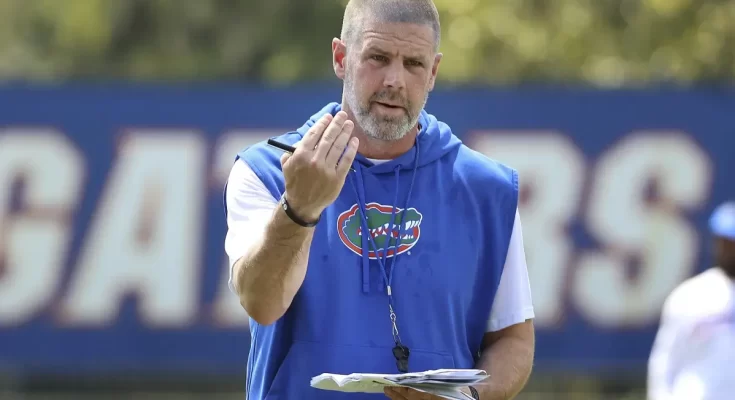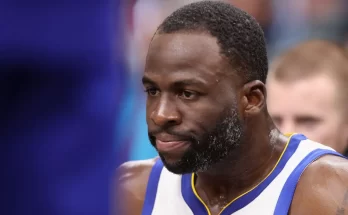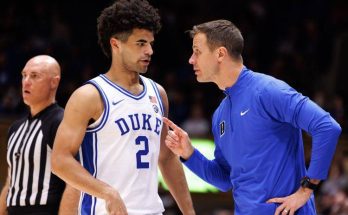Florida Gators head coach Billy Napier reveals that the team’s roster will feature approximately 120 players, with current walk-ons being grandfathered into the program.
Florida Gators head coach Billy Napier has recently provided a clear picture of what the team’s roster structure will look like moving forward, and his statements have sparked conversations not just among Gator fans, but across college football circles. According to Napier, the Florida football roster is expected to be “around 120” players, with all current walk-ons being grandfathered in under the current system. This is more than just a simple statement about numbers—it offers a glimpse into how Napier is shaping the culture, competitiveness, and future of the Gators’ football program. To fully appreciate the significance of his words, it’s important to consider not just the number of players on the roster, but also what it means for team depth, player development, and Florida’s overall strategy as the college football landscape continues to evolve.
Napier, who is entering a crucial phase of his tenure at Florida, understands the balance between recruiting elite scholarship athletes and developing walk-ons into contributors who can play valuable roles on the team. Walk-ons, often overlooked in the grand scheme of college football, represent more than just practice squad players; they embody work ethic, resilience, and the determination to compete without the guarantees that scholarship players enjoy. By ensuring that these walk-ons are grandfathered in, Napier is sending a clear message about inclusivity and rewarding those who have already committed to the program. This decision is not only a morale booster for the players who came in as walk-ons but also a sign of continuity as the program adapts to a new era of roster management.
The number 120 might seem arbitrary at first, but in college football, roster size is a strategic element. While the NCAA officially limits scholarship players to 85, the total roster, including walk-ons, can vary depending on the program’s resources and coaching philosophy. Some coaches prefer smaller rosters to maximize individual attention, while others see the value of maintaining a larger group for the sake of competition and depth, especially during physically demanding seasons. Napier’s choice to maintain a roster “around 120” suggests that he wants ample competition across every position, ensuring that no player becomes complacent. It also means that the Gators will have a wealth of options during practices, which can create more game-like scenarios and better prepare the team for high-pressure situations.
Another key point in Napier’s statement is the long-term vision it reveals. By focusing on both scholarship players and walk-ons, he is ensuring that Florida’s football culture is built on accountability and effort. Walk-ons often bring a chip-on-the-shoulder mentality that can push scholarship players to elevate their performance. In many successful programs across the country, walk-ons have emerged as unexpected stars. At Florida, this philosophy could pay dividends as the Gators look to climb back into the national championship conversation.
The college football landscape has undergone significant changes in recent years, particularly with the introduction of the transfer portal and NIL (Name, Image, Likeness) deals. These changes have added layers of complexity to roster management. Coaches like Napier have to not only recruit high school talent but also retain their current players and identify potential transfers who can fill immediate needs. Having a roster size of 120, with a mix of scholarship athletes and walk-ons, provides flexibility. It allows Napier to weather unexpected departures while continuing to develop players who may take time to reach their full potential. Grandfathering in walk-ons ensures that these players, who have already invested time and effort into the program, won’t be left behind as the roster evolves.
Beyond the numbers, Napier’s approach highlights his emphasis on building a strong team culture. Florida has a rich football tradition, with a fanbase that demands success and a history of producing championship-caliber teams. For Napier, who took over a program looking to regain its identity in the SEC, building a solid foundation is essential. By maintaining a roster size that encourages competition and rewards effort, he is creating an environment where players understand that nothing is given—it must be earned. This aligns perfectly with the values he has preached since arriving in Gainesville.
It’s also worth noting the logistical aspects of maintaining a roster of 120 players. From ensuring that all players have access to quality coaching, facilities, and nutrition, to managing practice reps and game preparations, this is no small task. Napier’s willingness to take on this challenge reflects his confidence in his staff and infrastructure. Florida’s facilities are among the best in college football, and with recent investments in state-of-the-art training centers, the Gators are well-positioned to support a roster of this size without sacrificing the quality of player development.
The inclusion of walk-ons in such a plan is a particularly interesting element. Many programs treat walk-ons as afterthoughts, but Napier’s decision to grandfather them in suggests he values their contributions to team chemistry and overall competitiveness. Walk-ons often handle crucial roles on scout teams, helping the starters prepare for upcoming opponents by simulating their schemes and tendencies. Their hard work behind the scenes can directly impact the team’s performance on game day, even if they rarely see the field themselves. By publicly acknowledging their importance, Napier is reinforcing the idea that every player in the program matters, regardless of scholarship status.
From a recruiting standpoint, Napier’s statement can also have ripple effects. High school recruits who are on the fringe of earning a scholarship might see Florida as a place where they can still have a meaningful opportunity to compete and grow, even if they initially come in as walk-ons. For a program trying to rebuild depth and regain prominence, having a strong pipeline of walk-ons who develop into contributors can be a significant advantage. It also reflects well on the program’s culture, which can be a selling point for both recruits and their families.
Napier’s philosophy here mirrors the approach taken by some of the most successful coaches in recent history. Coaches like Dabo Swinney at Clemson and Lincoln Riley have emphasized the importance of building a family-oriented program where every player feels valued. By setting the roster around 120, Napier is ensuring that Florida maintains a healthy mix of scholarship talent and developmental players, all while fostering a competitive environment.
The timing of this statement is also notable. Florida is preparing for a challenging schedule in the upcoming season, one that will test the depth and resilience of the roster. Having a larger pool of players means the Gators can rotate more during practices, reducing the risk of burnout and injuries while keeping the team fresh. It also means that when injuries inevitably occur during the grind of an SEC schedule, there are more players ready to step in and perform.
Furthermore, the decision to grandfather in walk-ons shows that Napier is committed to continuity rather than abrupt changes. In an era where players can transfer at the click of a button, building trust and stability within a roster is crucial. Players, especially walk-ons, want to feel like their efforts are recognized and valued. Napier’s statement provides reassurance that the Gators’ coaching staff respects the hard work these athletes have already put into the program.
Looking at the broader picture, this approach could influence other programs as well. College football is a copycat industry, and when a prominent SEC program like Florida sets a precedent, others may take notice. If the Gators see success with this roster structure, it wouldn’t be surprising to see other teams adopt similar strategies to balance scholarship limits, walk-on contributions, and the ever-changing dynamics of the transfer portal.
Napier’s announcement about keeping the roster “around 120” and grandfathering in walk-ons might seem like a simple logistical update, but it’s far more than that. It’s a strategic move that emphasizes competition, development, and culture—three pillars that will define Florida’s success in the coming years. It speaks to his belief in rewarding players who have already shown dedication to the program while also maintaining flexibility to adapt in a fast-changing college football environment. For fans, players, and recruits, this message offers clarity and confidence that the Gators are being built on a strong foundation. With Napier at the helm, the focus is not just on winning the next game, but on creating a sustainable model for long-term success, where every player—scholarship or walk-on—has a role to play in the journey back to national prominence.



